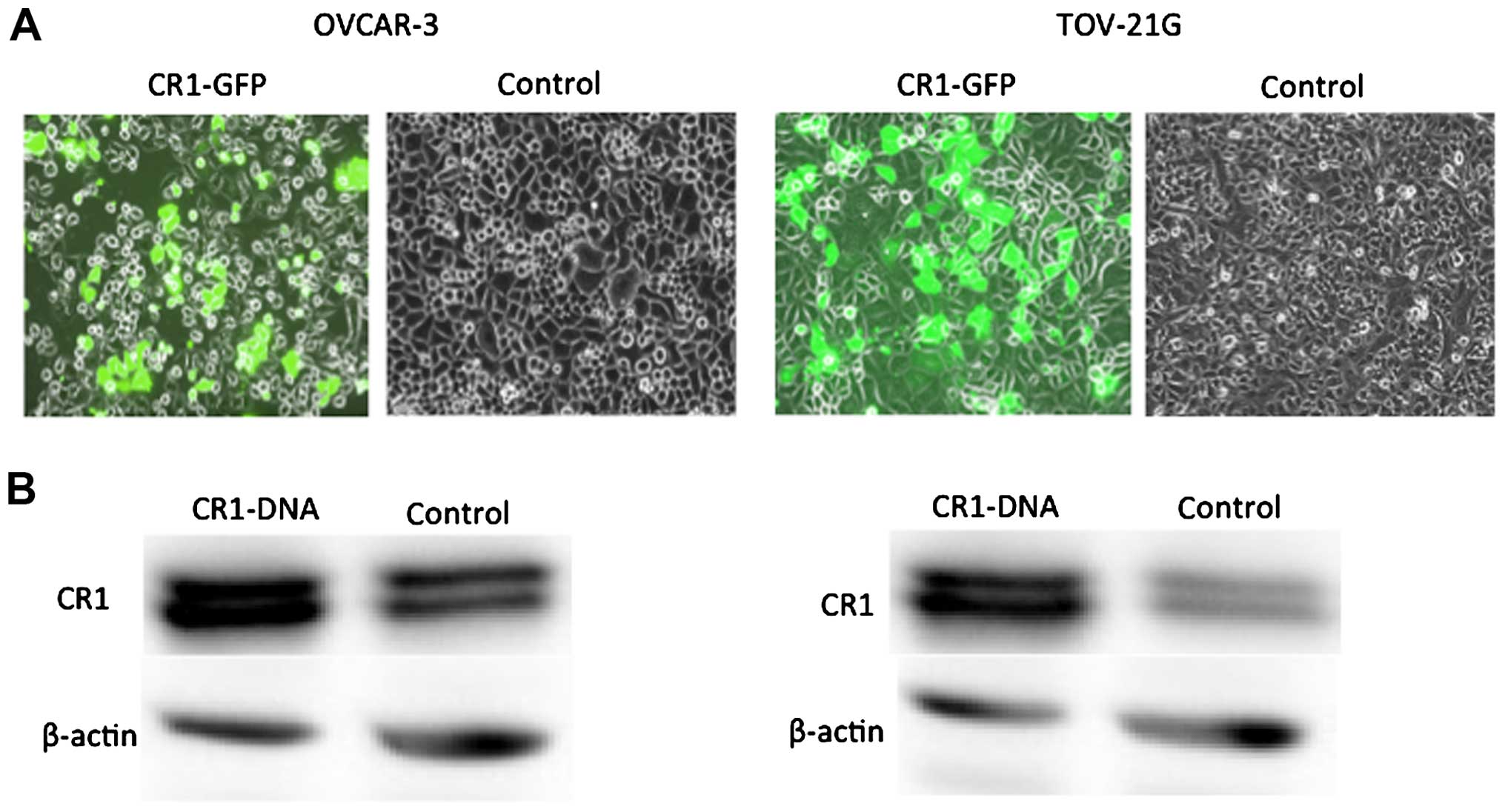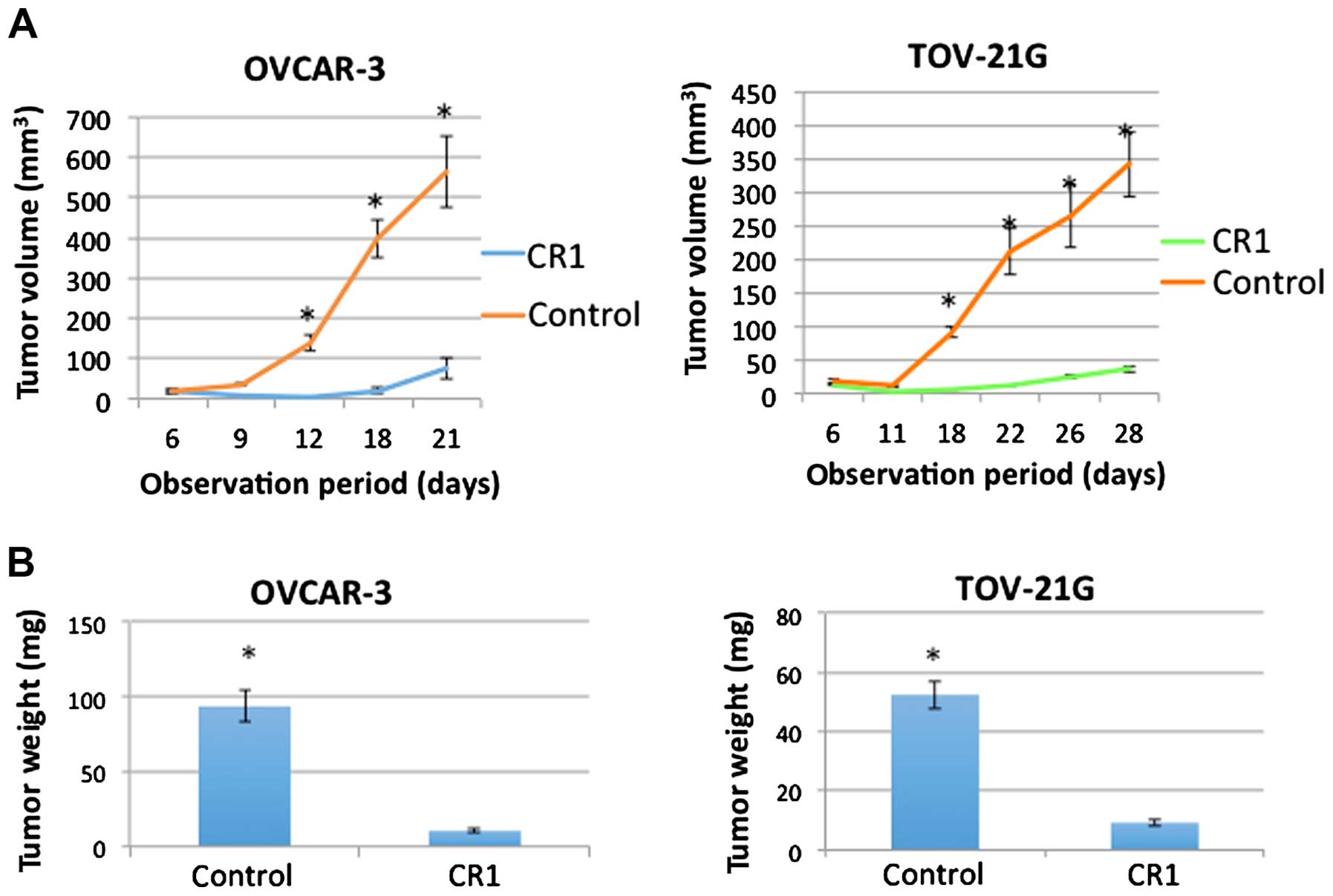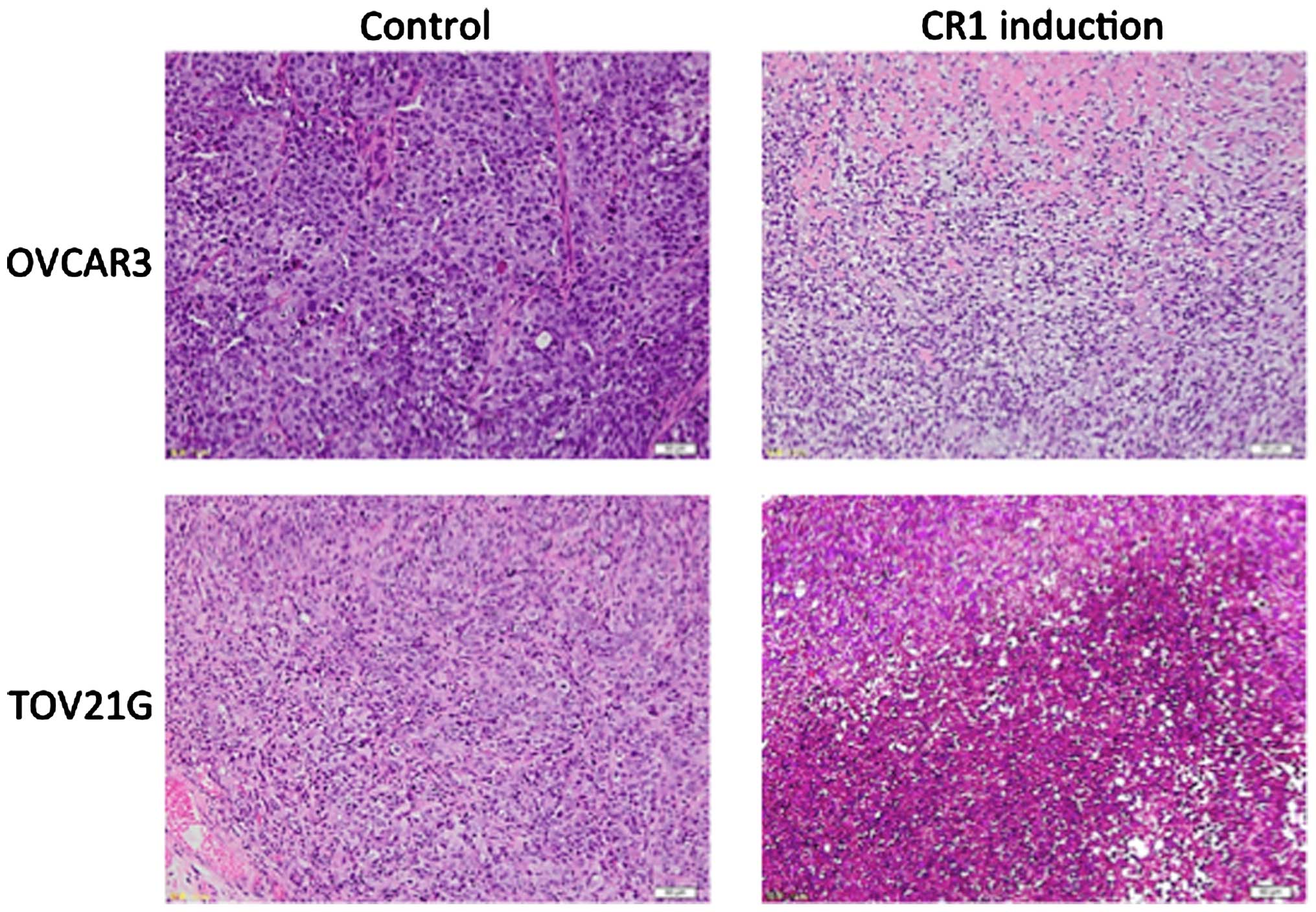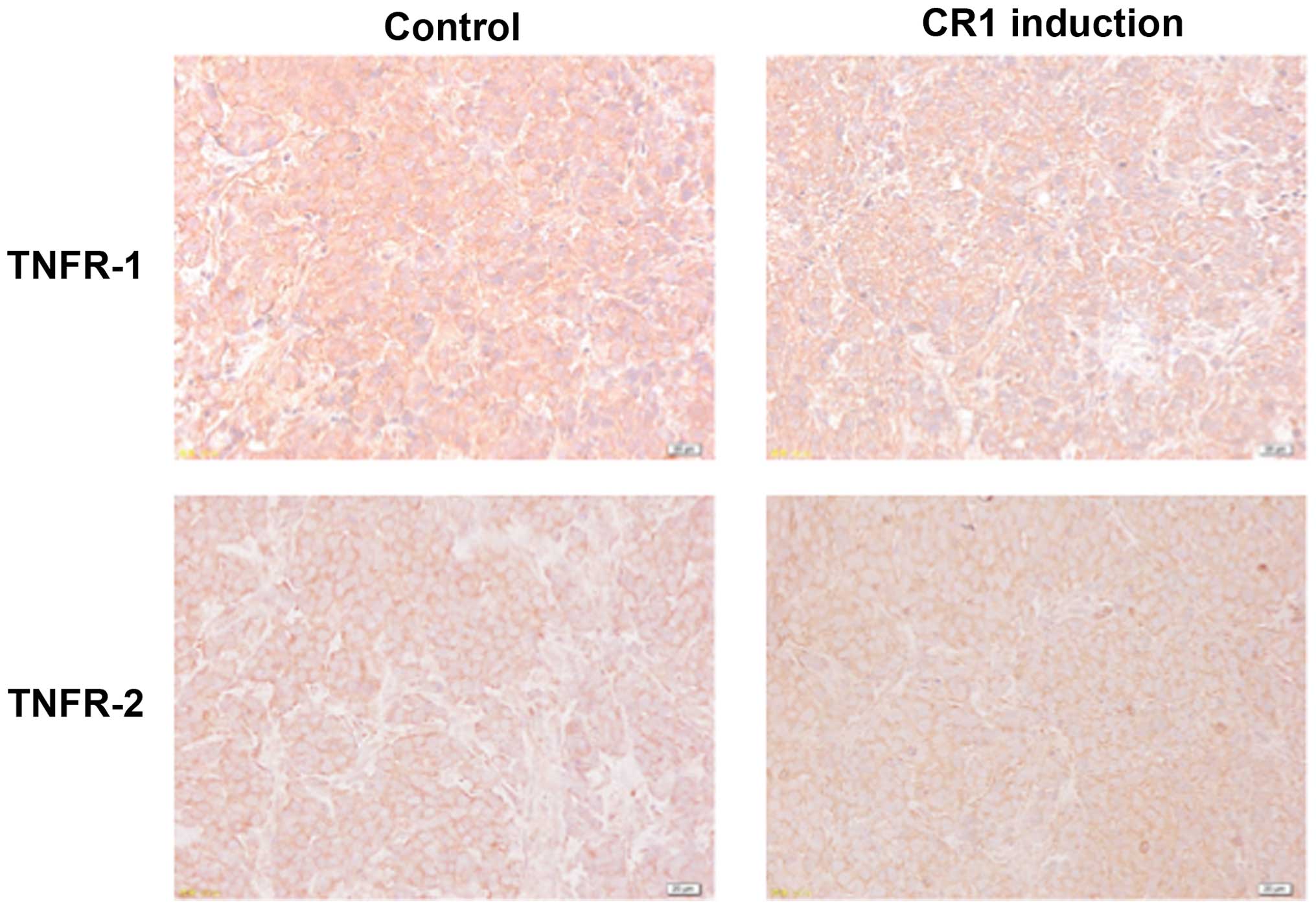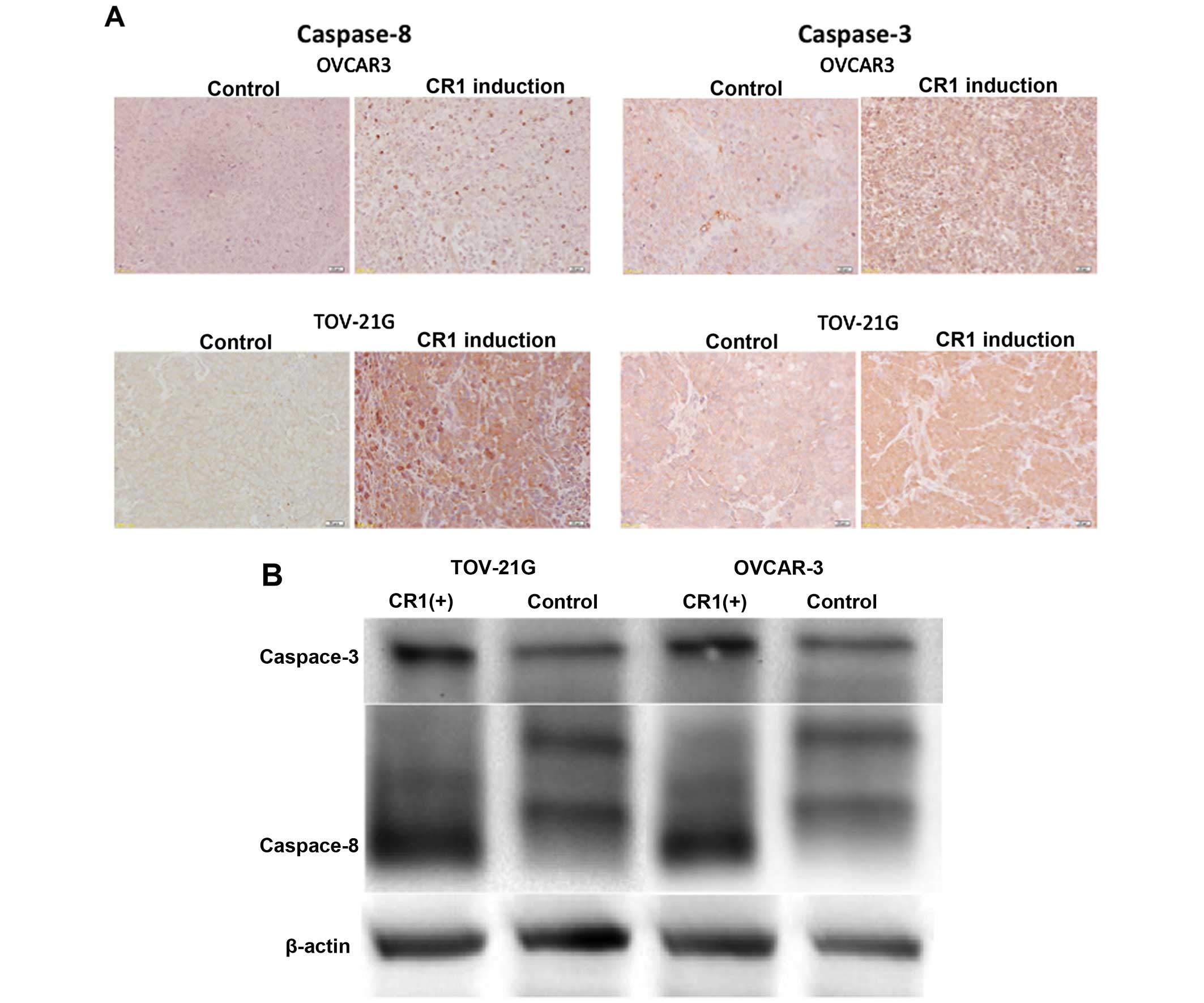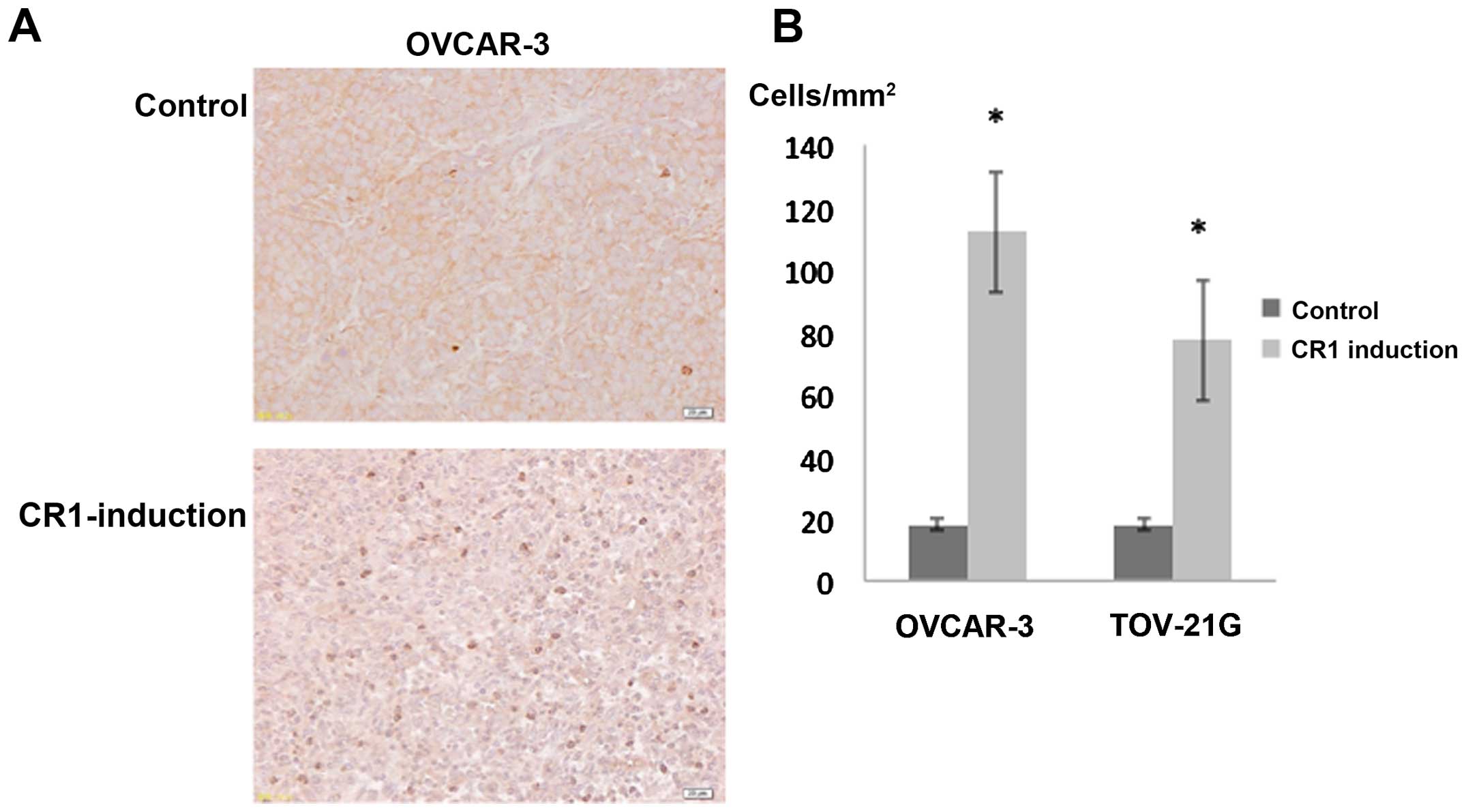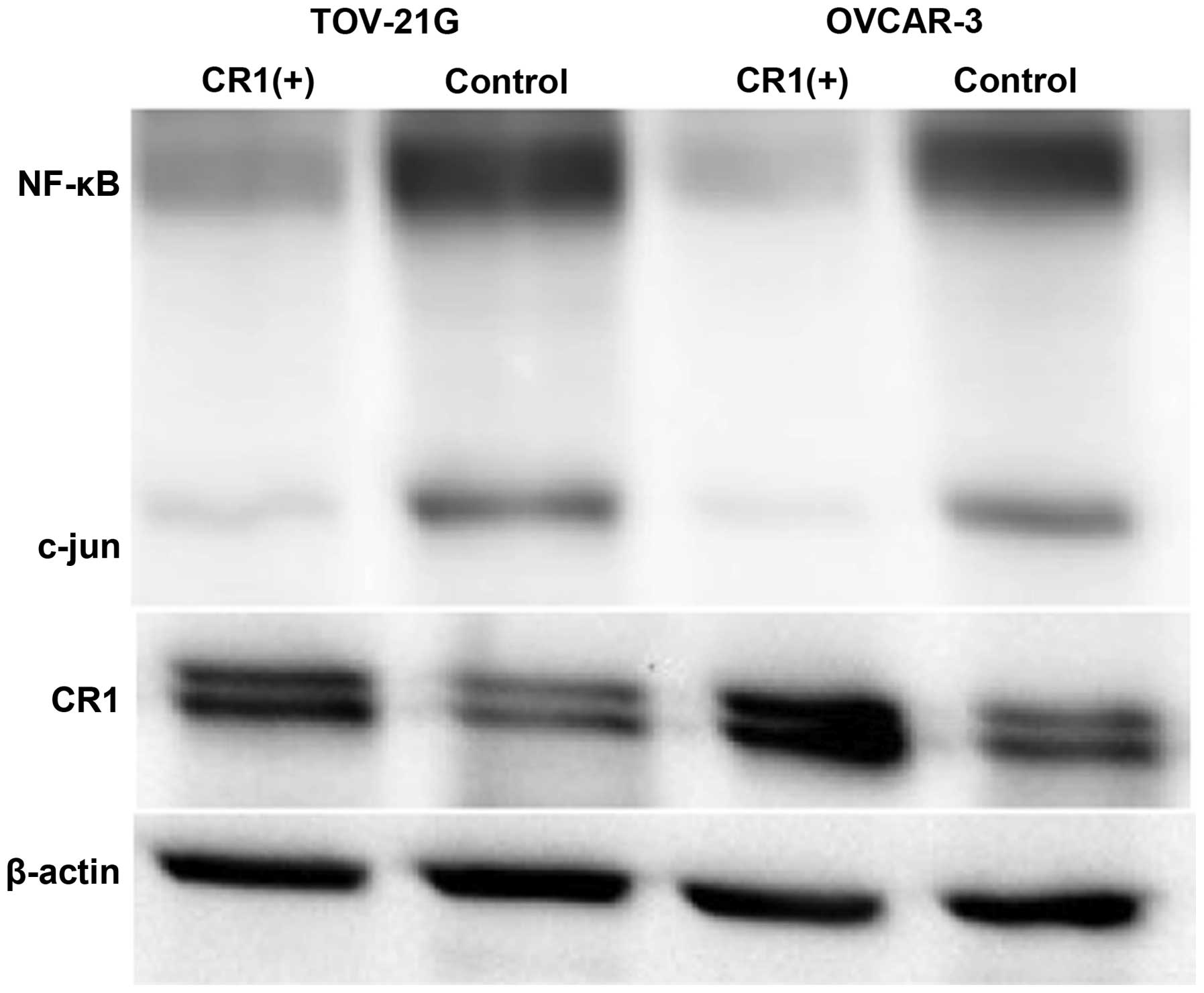Inhibitory effect of carbonyl reductase 1 on ovarian cancer growth via tumor necrosis factor receptor signaling
- Authors:
- Published online on: October 13, 2015 https://doi.org/10.3892/ijo.2015.3205
- Pages: 2173-2180
Abstract
Introduction
Ovarian cancer is the seventh most common cancer in women under the age of 65 years. Epithelial ovarian cancer (EOC) constitutes the majority of ovarian neoplasms (1). It is often not detected until the advanced stages and is the most frequent cause of death among gynecologic cancers (2). Over the last several years, the treatment of ovarian cancer has not appreciably changed. Cytoreductive surgery followed by adjuvant chemotherapy is generally recommended as the primary treatment for advanced EOC. Over 70% of patients respond to chemotherapy initially, but ~50% of advanced cases will relapse (3). Many drugs have been developed so far to treat EOC; however, the improvement in the prognosis of EOC patients is insufficient. Therefore, new clinically useful biomarkers and new targets for EOC treatment need to be identified.
Clofibric acid (CA), a peroxisome proliferator-activated receptor α (PPARα) ligand, which is commonly used for the treatment of hyperlipidemia, may be one of the possible EOC treatments. Our previous in vivo and in vitro studies have demonstrated that CA has an antitumor effect against human ovarian cancer, which is comparable to that of cisplatin (4). We have previously shown that CA treatment induces the expression of carbonyl reductase 1 (CR1), which in turn decreased prostaglandin (PG) E2 levels; the treatment also causes significant induction of apoptosis and profound repression of angiogenesis (4). CR1 is a NADPH-dependent oxidoreductase with a broad specificity for carbonyl compounds, which reduces aldehydes and ketones (5). CR1 is present in a variety of organs, such as the liver, kidney, breast, ovary, and vascular endothelial cells, and its primary function is considered to control fatty acid metabolism (6). Earlier reports have shown that there is a negative relationship between CR1 expression levels and malignant tumor growth (7–10). In order to elucidate antitumor effect of CR1, we transfected mouse ovarian cancer cells with a CR1 cDNA expression vector and investigated the effect of overexpressed CR1 on tumor growth in vivo, and found that tumor growth was significantly inhibited in mice from the CR1 induction group compared to tumor development in animals injected with intact, unmodified cell lines (11). Furthermore, the milk fat globule EGF factor 8 (MFG-E8), an ‘eat-me signal’ for phagocytes such as macrophages, was expressed extensively in the cytoplasm of tumor cells and interstitial cells of mice from the CR1 induction group. MFG-E8 is released by apoptotic endothelial cells and induces engulfment of apoptotic cells by macrophage (12). Activated macrophages are the major source of tumor necrosis factor α (TNFα) and TNFα is a key cytokine involved in inflammation, cellular homeostasis, tumor progression and carcinogenesis (13).
Therefore, we focused on TNFα, a potent cytokine, which is produced by many types of cells, including macrophages. TNFα elicits a particularly broad spectrum of whole body and cellular responses, including activation and migration of immune cells, fever, acute phase response, cell proliferation, differentiation, and apoptosis (14). TNFα exerts its effects through two distinct receptors, TNF receptor 1 (TNFR1) and TNFR2 (15). Binding of the inherently trimeric TNFα to TNFR1 and TNFR2 induces receptor trimerization and recruitment of several signaling proteins to the cytoplasmic domains of the receptor (15). TNFR1 transduces apoptotic and anti-inflammatory signals through the recruitment of the Fas-associated death domain protein (FADD) and subsequent recruitment of caspase-8 (16,17). Thereafter, activated caspase-8 initiates a proteolytic cascade that involves other caspases (caspase-3, -6 and -7) and ultimately induces apoptosis (16,17). TNFR1 also mediates anti-apoptotic and inflammatory responses such as the induction of necrosis factor (NF)- κB through the recruitment of TNF-receptor-associated factor 2 (TRAF2) and receptor-interacting protein 1 (RIP1) (18,19). On the other hand, TNFR2 recruits TRAF2 and TRAF1 to transmit anti-apoptotic and inflammatory signals inducing the expression of NF-κB and c-Jun (20).
In this study, we investigated the mechanism of antitumor effects of CR1 mediated by TNFR1 and TNFR2 signaling.
Materials and methods
Cell lines and cell culture
OVCAR-3 and TOV-21G cell lines were obtained from the American Type Culture Collection (Rockville, MD, USA). Both OVCAR-3 and TOV-21G cells are derived from human ovarian cancer tissues and are commonly used to produce xenografted solid tumors (10,21–23). The cells were cultured in the RPMI-1640 medium supplemented with 10% fetal calf serum (FCS), 100 U/ml penicillin, and 100 mg/ml streptomycin at 37°C in a humidified air containing 5% CO2.
Animal experiments
Animal experiments were conducted in accordance with the Guidelines for Animal Experimentation of Hirosaki University. Eight-week-old female BALB/c nu/nu mice were used in this study. All mice were group housed in plastic cages with stainless-steel grid tops in an air-conditioned room at the Institute for Animal Experiments of Hirosaki University. Mice were kept on a 12/12-h light/dark cycle and given ad libitum access to food and water.
Plasmid DNA preparation
To achieve highly efficient transfection, we used the pCMV6-AC-GFP vector (OriGene Technologies, Rockville, MD, USA) that encodes human CR1, the green fluorescent protein (GFP), and the ampicillin-resistant gene. For amplification, pCMV6-AC-GFP was transformed into E. coli DH5α competent cells by heat shock transformation according to standard laboratory protocols. The transformed bacteria were amplified in LB-ampicillin medium. The plasmids were purified from cultured-transformed bacteria using Maxiprep PureLink HiPure Plasmid Filter DNA Purification kits (Invitrogen, Carlsbad, CA, USA) according to the manufacturer's protocol. Plasmid DNA (pDNA) was diluted in sterile water to a concentration of 2 μg/μl.
Transfection
OVCAR-3 and TOV-21G cells were plated into 10-cm well plates and cultured to 70–80% confluence in the RPMI-1640 medium supplemented with 10% fetal calf serum (FCS). Then, 24 μg of the coding plasmid was transfected into OVCAR-3 and TOV-21G cells using Lipofectamine (Life Technologies, Rockville, MD, USA) according to the manufacturer's protocol. The vector without CR1 pDNA was used as control. Transfected cells were cultured in the RPMI-1640 medium supplemented with 10% fetal calf serum (FCS) for 48 h. We confirmed the expression of the CR construct using fluorescence microscopy.
Xenograft mouse model
The mice were divided into two groups (n=5 for each group) for each of the two types of cancer cells used. Normal OVCAR-3 cells or OVCAR-3 overexpressing the CR1-DNA (5.0×106 cells) were injected subcutaneously in 0.2 ml of RPMI-1640 medium into the back region of nude mice. All mice were numbered, housed separately, and tumor development was examined by measuring 2 diameters twice a week using a caliper. Tumor dimensions were measured twice a week using a caliper. Tumor volume was calculated using the following equation: V (mm3) = A x B2/2, where A is the largest diameter and B is the smallest diameter (10). On the third or fourth week of the experiment, animals were sacrificed and tumors were isolated for pathological and biochemical examinations.
Immunohistochemistry
Six-micrometer-thick sections of formalin-fixed and paraffin-embedded tissue specimens were stained by an established method, as described previously (4). Sections were incubated with antibodies specific for TNFR1, TNFR2, caspase-8, caspase-3, NF-κB, and c-Jun (Santa Cruz Biotechnology, Santa Cruz, CA, USA) overnight at 4°C. Slides were incubated with appropriate biotinylated species-specific secondary antibodies for 1 h and then exposed to avidin-biotin-peroxidase complex. Sections were treated with 0.02% diaminobenzidine as a chromogen and counterstained with hematoxylin.
Western blot analysis
Cell lysates (25 μg protein) were prepared from tumor tissues, electrophoresed using a 12% precast polyacrylamide gel onto nitrocellulose membranes (Bio-Rad Laboratories). The protein concentration was determined using the Bradford assay. The blots were probed for 2 h with the diluted antibodies against the following proteins: CR1 (Santa Cruz Biotechnology) at 1:500, human caspase-8 (Santa Cruz Biotechnology) at 1:200, caspase-3 (Santa Cruz Biotechnology) at 1:200, NF-κB (Santa Cruz Biotechnology) at 1:500, c-jun (Santa Cruz Biotechnology) at 1:500, and β-actin (Sigma-Aldrich, St. Louis, MO, USA) at 1:2,000. The membranes were then incubated for 1 h with the appropriate biotinylated secondary antibodies, and protein bands were visualized using enhanced chemiluminescence (Amersham Pharmacia Biotech, Piscataway, NJ, USA) according to the manufacturer's procedure.
Statistical analysis
Differences in the number of apoptotic cells between the CR1-overexpressing group and control were evaluated using Student's t-test. Differences in tumor volume between CR1-overexpressing group and control were also evaluated by Student's t-test. A result was deemed significant at a P-value <0.05.
Results
CR1 expression levels in normal and CR1-transfected OVAR-3 and TOV21-G cells
CR1 expression levels were compared in normal OVAR-3 and TOV21-G cells and cells transfected with CR1 cDNA. CR1-GFP protein was clearly detected in CR1-DNA transfected cells (Fig. 1A). Western blot analysis clearly showed high expression of CR1 protein in the CR1-DNA transfected cells compared to control (Fig. 1B).
Effects of CR1-transfection on tumor growth in vivo
As shown in Fig. 2A, OVCAR-3 and TOV-21G cells injected in mice formed tumors and showed significant increase in tumor volume by 12 or 18 days after injection (P<0.001), respectively. However, OVCAR-3 and TOV-21G cells transfected with CR1 showed no increase until 12 or 18 days after the injection. Although they showed a slight increase in the volume by the end of the experiment, both size and weight (Fig. 2, P<0.001) were significantly lower that those of normal OVCAR-3 and TOV-21G cells. These results suggested that transfection of CR1 caused an inhibitory effect on tumor growth.
Histological examination on the isolated tumor showed that while malignant cells were densely packed in tumor tissues of control groups (normal OVCAR-3 and TOV-21G cells), malignant cells were sparsely distributed in tumors derived from CR1-overexpressing cell lines (Fig. 3). Necrosis with inflammatory cells was observed in large areas of tumors in CR1 induction groups (Fig. 3).
Effects of CR1-transfection on TNFR1 and TNFR2 expression
Immunohistochemical analysis showed that TNFR1 was expressed on cell membranes of tumors from all treatment groups and there were no significant differences in its expression levels between CR1 induction and control groups (Fig. 4). TNFR2 expression levels were comparatively weak in both groups (Fig. 4).
Effect of CR1-transfection on caspase-8 and -3 expression
Immunohistochemical and western blot analysis showed a high expression of caspase-8 and -3 in tumors formed after injections of CR1-overexpressing OVCAR-3 and TOV-21G cells, respectively. In addition, very weak expression was observed in tumors caused by injections of intact cell lines (Fig. 5).
Effects of CR1-transfection on apoptotic cell number
The number of apoptotic cells per mm2 identified with an anti-caspase-8 antibody (24) was 112.0±19.5 and 77.2±12.8 in tumors caused by CR1-overexpressing OVCAR-3 and TOV-21G cells, respectively. Tumors induced by the injection of control OVCAR-3 and TOV-21G cells exhibited fewer apoptotic cells per mm2, that is, 18.0±7.7 and 17.6±1.8, respectively. The differences between control and CR1 induction groups were statistically significant (Fig. 6, P<0.001 each).
Effect of CR1-transfection on NF-κB and c-Jun expression
Western blot analysis showed that both NF-κB and c-Jun expression levels were lower in tumors caused by CR1-overexpressing OVCAR-3 and TOV-21G cells compared to their expression in tumors induced by control cell lines (Fig. 7).
Discussion
The results of this study show that subcutaneous injections of CR1-overexpressing OVCAR-3 and TOV-21G cells into the back region of nude mice formed smaller tumors in volume than injection with normal OVCAR-3 and TOV-21G cell lines and were compatible with our previous studies that showed spontaneous regression of malignant ovarian tumors with high expression of CR1 (11) and growth promotion of ovarian cancer cell lines by CR1 suppression (10). Because an increased expression of MFG-E8 in macrophages was also observed in our previous study (11), we speculated apoptosis as a putative mechanism of CR1 function. As shown in Fig. 5, we found that expression levels of caspase-8 and -3 were higher in tumors with CR1 overexpressed cell lines, confirming our hypothesis. In addition, expression levels of NF-κB and c-Jun were negatively affected in tumors with CR1 overexpression. NF-κB and c-Jun are known to cooperate to prevent apoptosis induced by TNFα, therefore we were interested to study TNFRs for TNFα with CR1.
TNFR1 is ubiquitously expressed in most tissues, whereas TNFR2 is mainly expressed in immune cells (13). Although both receptors bind TNFα, cellular effects of TNFα in most cell types are predominantly mediated by TNFR1 (25). TNFR1 is an important member of the death receptor family and is capable of inducing apoptotic cell death (26). TNFR2 can also mediate cell death signals, which may be indirectly communicated through TNFR1 (26). As shown in Fig. 4, TNFR1 was expressed to equal levels regardless of CR1 expression, while TNFR2 was expressed weaker in both groups, suggesting that TNFR1 signaling has a more important role in tumor development. In order that TNFR1 elicits physiological function, it trimerizes and releases the silencer of death domain protein, which recruits adaptor proteins such as RIP, TRAF-2, and FADD (15). FADD binds to pro-caspase-8 and activated caspase-8 subsequently initiates a proteolytic cascade that involves other caspases (caspase-3, -6 and -7) and ultimately induces apoptosis (16,27). As shown in Fig. 5, because expression levels of caspase-8 and -3 were higher in CR1 overexpressing tumors, it is presumed that CR1 induced apoptosis through the activation of caspase pathway. In addition, expression of NF-κB and c-Jun was lower in CR1-overexpressing tumors. NF-κB and c-Jun have been shown to induce transcription of genes related to proliferation and anti-apoptosis (13). Therefore, apoptosis induced by CR-1 overexpression can be accounted for by reduced expression of NF-κB and c-Jun. These results were compatible with earlier reports that showed an inhibitory effect of NF-κB on ovarian cancer growth (28,29).
In conclusion, the results of this study show that CR1 has anticancer effects by inducing apoptosis through the TNFα system. Of interest, CR1 induced apoptosis of TOV-21G cell lines which are derived from chemo-resistant ovarian clear cell adenocarcinoma (30). Clear cell carcinoma is one of the most frequent of ovarian cancers and has poor prognosis (30), then the results of present study suggests that CR1 might become a new candidate for treatment of clear cell carcinoma. Further studies are required for clinical application of a PPARα ligand or CR1 gene therapy.
Acknowledgements
This study was supported by a Grant-in Aid for Cancer Research from the Ministry of Education, Science and Culture of Japan (no. 20591935 to Y. Yokoyama).
References
|
Siegel R, Naishadham D and Jemal A: Cancer statistics, 2013. CA Cancer J Clin. 63:11–30. 2013. View Article : Google Scholar : PubMed/NCBI | |
|
Heintz AP, Odicino F, Maisonneuve P, Quinn MA, Benedet JL, Creasman WT, Ngan HY, Pecorelli S and Beller U: Carcinoma of the ovary = FIGO 26th Annual Report on the Results of Treatment in Gynecological Cancer. Int J Gynaecol Obstet. 95(Suppl 1): S161–S192. 2006. View Article : Google Scholar | |
|
McGuire WP, Hoskins WJ, Brady MF, Kucera PR, Partridge EE, Look KY, Clarke-Pearson DL and Davidson M: Cyclophosphamide and cisplatin compared with paclitaxel and cisplatin in patients with stage III and stage IV ovarian cancer. N Engl J Med. 334:1–6. 1996. View Article : Google Scholar : PubMed/NCBI | |
|
Yokoyama Y, Xin B, Shigeto T, Umemoto M, Kasai-Sakamoto A, Futagami M, Tsuchida S, Al-Mulla F and Mizunuma H: Clofibric acid, a peroxisome proliferator-activated receptor α ligand, inhibits growth of human ovarian cancer. Mol Cancer Ther. 6:1379–1386. 2007. View Article : Google Scholar : PubMed/NCBI | |
|
Gonzalez-Covarrubias V, Ghosh D, Lakhman SS, Pendyala L and Blanco JG: A functional genetic polymorphism on human carbonyl reductase 1 (CBR1 V88I) impacts on catalytic activity and NADPH binding affinity. Drug Metab Dispos. 35:973–980. 2007. View Article : Google Scholar : PubMed/NCBI | |
|
Wermuth B, Bohren KM, Heinemann G, von Wartburg JP and Gabbay KH: Human carbonyl reductase. Nucleotide sequence analysis of a cDNA and amino acid sequence of the encoded protein. J Biol Chem. 263:16185–16188. 1988.PubMed/NCBI | |
|
Umemoto M, Yokoyama Y, Sato S, Tsuchida S, Al-Mulla F and Saito Y: Carbonyl reductase as a significant predictor of survival and lymph node metastasis in epithelial ovarian cancer. Br J Cancer. 85:1032–1036. 2001. View Article : Google Scholar : PubMed/NCBI | |
|
Murakami A, Fukushima C, Yoshidomi K, Sueoka K, Nawata S, Yokoyama Y, Tsuchida S, Ismail E, Al-Mulla F and Sugino N: Suppression of carbonyl reductase expression enhances malignant behaviour in uterine cervical squamous cell carcinoma: Carbonyl reductase predicts prognosis and lymph node metastasis. Cancer Lett. 311:77–84. 2011. View Article : Google Scholar : PubMed/NCBI | |
|
Murakami A, Yakabe K, Yoshidomi K, Sueoka K, Nawata S, Yokoyama Y, Tsuchida S, Al-Mulla F and Sugino N: Decreased carbonyl reductase 1 expression promotes malignant behaviours by induction of epithelial mesenchymal transition and its clinical significance. Cancer Lett. 323:69–76. 2012. View Article : Google Scholar : PubMed/NCBI | |
|
Osawa Y, Yokoyama Y, Shigeto T, Futagami M and Mizunuma H: Decreased expression of carbonyl reductase 1 promotes ovarian cancer growth and proliferation. Int J Oncol. 46:1252–1258. 2015.PubMed/NCBI | |
|
Wang H, Yokoyama Y, Tsuchida S and Mizunuma H: Malignant ovarian tumors with induced expression of carbonyl reductase show spontaneous regression. Clin Med Insights Oncol. 6:107–115. 2012.PubMed/NCBI | |
|
Hanayama R, Tanaka M, Miwa K, Shinohara A, Iwamatsu A and Nagata S: Identification of a factor that links apoptotic cells to phagocytes. Nature. 417:182–187. 2002. View Article : Google Scholar : PubMed/NCBI | |
|
van Horssen R, Ten Hagen TL and Eggermont AM: TNF-alpha in cancer treatment: Molecular insights, antitumor effects, and clinical utility. Oncologist. 11:397–408. 2006. View Article : Google Scholar : PubMed/NCBI | |
|
Tracey KJ and Cerami A: Tumor necrosis factor, other cytokines and disease. Annu Rev Cell Biol. 9:317–343. 1993. View Article : Google Scholar : PubMed/NCBI | |
|
Vandenabeele P, Declercq W, Beyaert R and Fiers W: Two tumour necrosis factor receptors: Structure and function. Trends Cell Biol. 5:392–399. 1995. View Article : Google Scholar : PubMed/NCBI | |
|
Rath PC and Aggarwal BB: TNF-induced signaling in apoptosis. J Clin Immunol. 19:350–364. 1999. View Article : Google Scholar | |
|
Degterev A, Boyce M and Yuan J: A decade of caspases. Oncogene. 22:8543–8567. 2003. View Article : Google Scholar : PubMed/NCBI | |
|
Barnes PJ and Karin M: Nuclear factor-kappaB: A pivotal transcription factor in chronic inflammatory diseases. N Engl J Med. 336:1066–1071. 1997. View Article : Google Scholar : PubMed/NCBI | |
|
Karin M, Liu Z and Zandi E: AP-1 function and regulation. Curr Opin Cell Biol. 9:240–246. 1997. View Article : Google Scholar : PubMed/NCBI | |
|
Rothe M, Pan M-G, Henzel WJ, Ayres TM and Goeddel DV: The TNFR2-TRAF signaling complex contains two novel proteins related to baculoviral inhibitor of apoptosis proteins. Cell. 83:1243–1252. 1995. View Article : Google Scholar : PubMed/NCBI | |
|
Shigeto T, Yokoyama Y, Xin B and Mizunuma H: Peroxisome proliferator-activated receptor α and γ ligands inhibit the growth of human ovarian cancer. Oncol Rep. 18:833–840. 2007.PubMed/NCBI | |
|
Wakui M, Yokoyama Y, Wang H, Shigeto T, Futagami M and Mizunuma H: Efficacy of a methyl ester of 5-aminolevulinic acid in photodynamic therapy for ovarian cancers. J Cancer Res Clin Oncol. 136:1143–1150. 2010. View Article : Google Scholar : PubMed/NCBI | |
|
Cebulla J, Huuse EM, Pettersen K, van der Veen A, Kim E, Andersen S, Prestvik WS, Bofin AM, Pathak AP, Bjørkøy G, et al: MRI reveals the in vivo cellular and vascular response to BEZ235 in ovarian cancer xenografts with different PI3-kinase pathway activity. Br J Cancer. 112:504–513. 2015. View Article : Google Scholar | |
|
Hirakawa H, Yokoyama Y, Yoshida H and Mizunuma H: Inhibitory effects of aromatase inhibitor on estrogen receptor-alpha positive ovarian cancer in mice. J Ovarian Res. 7:42014. View Article : Google Scholar : PubMed/NCBI | |
|
McFarlane SM, Pashmi G, Connell MC, Littlejohn AF, Tucker SJ, Vandenabeele P and MacEwan DJ: Differential activation of nuclear factor-kappaB by tumour necrosis factor receptor subtypes. TNFR1 predominates whereas TNFR2 activates transcription poorly. FEBS Lett. 515:119–126. 2002. View Article : Google Scholar : PubMed/NCBI | |
|
Wajant H, Pfizenmaier K and Scheurich P: Tumor necrosis factor signaling. Cell Death Differ. 10:45–65. 2003. View Article : Google Scholar : PubMed/NCBI | |
|
Naudé PJ, den Boer JA, Luiten PG and Eisel UL: Tumor necrosis factor receptor cross-talk. FEBS J. 278:888–898. 2011. View Article : Google Scholar : PubMed/NCBI | |
|
Zerbini LF, Tamura RE, Correa RG, Czibere A, Cordeiro J, Bhasin M, Simabuco FM, Wang Y, Gu X, Li L, et al: Combinatorial effect of non-steroidal anti-inflammatory drugs and NF-κB inhibitors in ovarian cancer therapy. PLoS One. 6:e242852011. View Article : Google Scholar | |
|
Nishio H, Yaguchi T, Sugiyama J, Sumimoto H, Umezawa K, Iwata T, Susumu N, Fujii T, Kawamura N, Kobayashi A, et al: Immunosuppression through constitutively activated NF-κB signalling in human ovarian cancer and its reversal by an NF-κB inhibitor. Br J Cancer. 110:2965–2974. 2014. View Article : Google Scholar : PubMed/NCBI | |
|
Takano M, Sugiyama T, Yaegashi N, Sagae S, Kuzuya K, Udagawa Y, Tsuda H, Suzuki M, Kigawa J, Goto T, et al: Less impact of adjuvant chemotherapy for stage I clear cell carcinoma of the ovary: A retrospective Japan Clear Cell Carcinoma Study. Int J Gynecol Cancer. 20:1506–1510. 2010.PubMed/NCBI |



